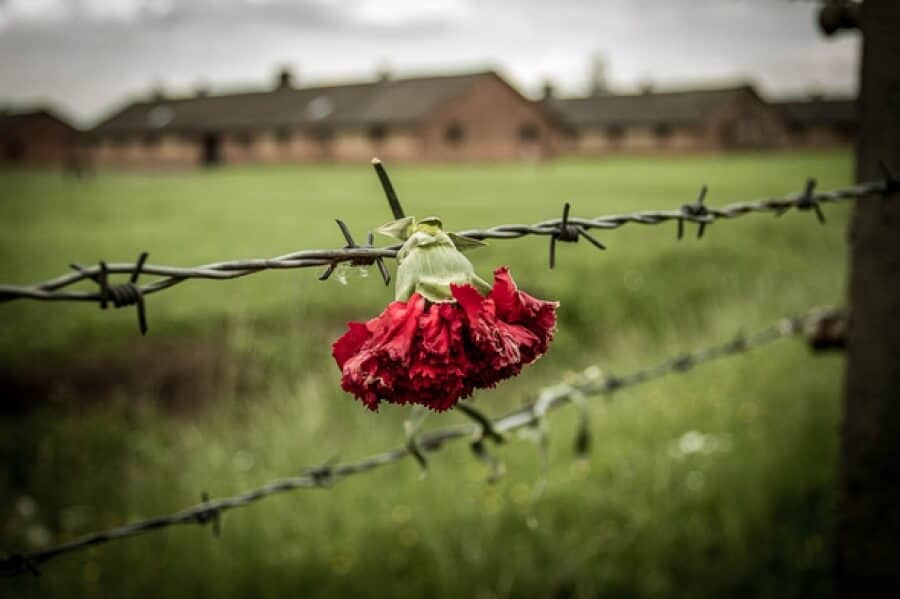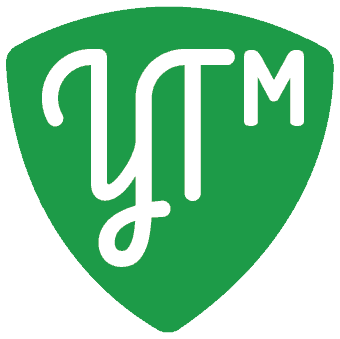"They transported us in wooden carriages. Another group of prisoners arrived along with us. They loaded them into trucks, but we for some reason had to go on foot. I remember the parade ground and these strange chimneys pouring with black smoke. We asked, “What exactly are they manufacturing for you in these factories?” But it was the people they had forced into the trucks they were burning." – From the memoirs of Yelena Kharina, a Soviet intelligence agent and Auschwitz prisoner.
The atmosphere in here hangs heavy, even now. The air seems thicker, harder to breathe, and then when it enters your lungs and spreads throughout your body, it starts to feel very cold and creepy. The sky seems greyer, as if it wants to cloak the place and hide it away. And time – time here has long since stopped.
As you approach Auschwitz II (known as Birkenau), the former German concentration camp, a rust-coloured, brick building and one solitary railway leading beyond its gates come into view. Just how many people went through those gates? How many of them knew that this road would not only literally terminate after a few hundred metres but would also terminate in the lives of a huge number of people?

It’s probable that we will never know for sure. But whatever the exact figures are – one million, one and a half million, two or two and a half million – any of them would allow us to call Auschwitz a factory for the mass murder of people. A factory of death, where there was no mercy for anyone. A place where all conceivable and inconceivable human cruelty was concentrated.
“Auschwitz – I read on the platform. There we saw a group of men and women, around 50 people, guarded by SS soldiers. On their chests and backs were big, yellow stars. All of them were well-dressed and if it weren’t for the stars and soldiers, they could have been taken for a group of tourists on their way somewhere.”
– From the memoirs of Evgeny Eminov, Soviet engineer and Auschwitz prisoner.
What details of the killing machine survive today?
Inside the actual camp, beyond the gates of death and on the rails of that same railway, stands a single wooden cargo carriage. There are almost no windows in it, no heating and practically no ventilation. 70 years ago, this carriage, along with several hundred more like it, delivered prisoners to Auschwitz. According to various sources up to 400 of these carriages arrived here per day. During the transportation of the prisoners they were not opened.

“There were several stops, but they didn’t let us out. They didn’t open the doors either, not even for ventilation. The air got in through small windows along the sides of the carriages. Some of us begged through the windows for them to give us a little water just so we might at least wet our lips a bit. But the Germans didn’t allow anyone near the carriages.”
– From the memoirs of a member of Sonderkommando I and an Auschwitz prisoner, Eliezer Eisenschmidt.

The barracks. The majority of the barracks were wooden and now lie in ruin. Only part of the brick barracks and brick canteen remain original. Several of them are open to visitors. The inhuman conditions the Auschwitz prisoners were kept under are well-known. Wooden plank beds stacked three high covered with a thin layer of straw. That was all they had by way of comfort. But the alternative to those barracks was much more horrific.

“They gave us food only five days after. Some people walked by the window. We said, “They bake bread day and night but they don’t give us any. We’re so hungry!” But they told us, “That’s not a bakery, it’s a crematorium. They burn people there – alive and dead.”
– From the memoirs of Soviet Auschwitz prisoner, Eleonora Filonova.
The ruins of the two main crematoria along with the gas chambers are located at the end of the railway tracks. This was where the majority of Auschwitz prisoners met their death. They say that the smoke from these chimneys poured out both day and night, stopping for only three hours a day while they cleaned out the human ashes. In order not to instil panic, the Nazis sent prisoners to the chambers under the pretext of disinfection. People went thinking they were baths, only instead of steam, they were given the crystalline gas, Zyklon B.
“They brought us out into the courtyard and opened the doors of the place which was used as a gas chamber and we started to feel sick. What we saw I wouldn’t have imagined even in my most terrifying nightmares. There was the dead naked body of a woman. She was bent double. We could not comprehend what had happened there. We saw bodies inside the gas chamber. It seemed like they had turned into one homogenous mass. Then came the orders: put on gas masks, go inside, remove the bodies. Dentists, examine mouths and pull out golden teeth with pliers. Hairdressers, cut off their hair.”
– From the memoirs of a member of Sonderkommando I and Auschwitz prisoner, Eliezer Eisenschmidt.

This area is now fenced off and there’s a warning sign in front of it saying ‘Keep off the ruins.’ Well, no one dares to step over to the collapsed building; there have been enough victims here. Occasionally though, a young man or woman with an Israeli flag might walk right up to the tape barrier, drop to their knees, bow their head and cry bitterly, murmuring softly to themselves.

Apart from the watch towers, nothing more remains of the Auschwitz II-Birkenau camp. All physical evidence and the prisoners’ personal belongings are displayed at the museum’s other site – the Auschwitz I camp. That camp was built first and took in the first prisoners, and its gates are the ones that display the cynical slogan: ‘Arbeit Macht Frei’. This is where the administrative buildings of the SS were located and where the first tests to poison people with Zyklon B were conducted.
“In the beginning we didn’t know what dosage needed to be administered for a person to die. This continued for several days. The doors were opened, people were checked to see if they were still alive, the doors were closed and the next dosage administered. And thus it was gauged how much was needed.”
– From the testimony of Auschwitz commandant, Rudolf Höss.

If visiting Birkenau is emotionally draining, then visiting Auschwitz I is practically impossible. At first, the narrow streets and closely built buildings appear like some average town. But going deeper into it you begin to notice the bars on the windows, the sentry boxes between the buildings and instead of courtyards a wall of death and the grey, concrete perimeter fence. That’s when you realise that this was not a town for living in, at least not for the majority of its inhabitants.
Take for example the basement of Block 11, one of the most horrible places of punishment. Here there are four narrow cells measuring 90×90 cm. You could only stand in them. And people stood there without food and water sometimes for several days.

However, the most horrific block in Auschwitz I nowadays is Block 5. This is where, after the Red Army’s liberation of the camp, all the remaining physical evidence of the crimes committed in Auschwitz was gathered. Thousands of pairs of glasses, shaving brushes, toothbrushes, combs, suitcases with the owners’ family names written on them and a mountain of shoes which people left before the ‘ceremonial bath’.

A separate room was dedicated to children’s belongings: potties, toys, clothes and shoes. It’s practically impossible to endure this sight and you get the urge to leave quickly.
“Once they found a young girl who clearly hadn’t inhaled enough gas. She was unconscious but still alive and she was wheezing. The German sergeant shot her.”
– From the memoirs of a member of the Sonderkommando I, Auschwitz prisoner Eliezer Eisenschmidt.

The gates of the death factory known as Auschwitz closed. More precisely they were closed by Soviet soldiers exactly 70 years ago on 27 January 1945. Of more than a million prisoners brought here, only a few thousand were saved.
“We ran up to them and they gave us hugs, cookies, and chocolate. Being so alone a hug meant more than anybody could imagine because that replaced the human worth that we were starving for. We were not only starved for food but we were starved for human kindness. And the Soviet Army did provide some of that.”
– From the memoirs of survivor of Auschwitz Eva Mozes Kor.

Against the backdrop of such a large-scale tragedy for all humanity, arguments and speculation on this topic from some contemporary politicians look inappropriate to say the least. You can’t change history to suit the way the political winds are blowing. You can’t put personal ambitions and grudges above a date which symbolises one of the most horrific eras of modern history. There are two things history can’t withstand: conjecture in the subjunctive, and being forgotten. For a forgotten mistake is so easily repeated.
Support us!
All your donations will be used to pay the magazine’s journalists and to support the ongoing costs of maintaining the site.
Share this post
Interested in co-operating with us?
We are open to co-operation from writers and businesses alike. You can reach us on our email at [email protected]/[email protected] and we will get back to you as quick as we can.











